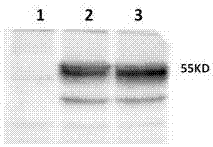Anti-human B7-H4 extracellular monoclonal antibody secreting hybridoma cell strain, anti-human B7-H4 monoclonal antibody and application thereof
A hybridoma cell line and monoclonal antibody technology, which is applied in the field of immune applications, can solve the problems of inability to resist tumor immune responses, and achieve the effects of good passaging ability, high specificity, and high affinity
- Summary
- Abstract
- Description
- Claims
- Application Information
AI Technical Summary
Problems solved by technology
Method used
Image
Examples
Embodiment 1
[0043] The hybridoma cell lines secreting anti-human B7-H4 extracellular monoclonal antibody in this example, including five hybridoma cells capable of producing high-titer monoclonal antibodies, are all preserved in the China Center for Type Culture Collection, and the preservation address is Wuhan University , the deposit date is April 19, 2017, and the naming and deposit numbers are:
[0044] (1) Culture name (classification naming): hybridoma cell line 1C1H11, deposit number: CCTCC NO: C201758;
[0045] (2) Culture name (classification naming): hybridoma cell line 3E5G7, deposit number: CCTCC NO: C201759;
[0046] (3) Culture name (classification naming): hybridoma cell line 8H3C4, deposit number: CCTCC NO: C201760;
[0047] (4) Culture name (classification naming): hybridoma cell line 12B2E1, deposit number: CCTCC NO: C201761;
[0048] (5) Culture name (classification naming): hybridoma cell line 12H6G1, deposit number: CCTCC NO: C201762.
Embodiment 2
[0050] The anti-human B7-H4 monoclonal antibody of this embodiment is characterized in that: the anti-human B7-H4 monoclonal antibody is produced by the hybridoma cell line that secretes anti-human B7-H4 extracellular monoclonal antibody according to claim 1 of monoclonal antibodies.
[0051] Wherein, the anti-human B7-H4 monoclonal antibody is a monoclonal antibody prepared directly by using eukaryotically expressed soluble human B7-H4 monomeric protein as an antigen.
[0052] The anti-human B7-H4 monoclonal antibody can be used in the following aspects:
[0053] (1) Establish immunological methods such as ELISA, chemiluminescence, and immunofluorescence to detect the concentration of soluble B7-H4 protein in human peripheral blood and other body fluids, for the treatment of immune diseases (including tumors, autoimmune diseases, infectious diseases, etc.) Clinical diagnosis, curative effect evaluation, prognosis judgment and pathogenesis research;
[0054] (2) It is used f...
Embodiment 3
[0060] The application of the anti-human B7-H4 monoclonal antibody of this example in the preparation of a drug for flow cytometry detection of B7-H4 expressed on the surface of human cells.
PUM
 Login to View More
Login to View More Abstract
Description
Claims
Application Information
 Login to View More
Login to View More - R&D
- Intellectual Property
- Life Sciences
- Materials
- Tech Scout
- Unparalleled Data Quality
- Higher Quality Content
- 60% Fewer Hallucinations
Browse by: Latest US Patents, China's latest patents, Technical Efficacy Thesaurus, Application Domain, Technology Topic, Popular Technical Reports.
© 2025 PatSnap. All rights reserved.Legal|Privacy policy|Modern Slavery Act Transparency Statement|Sitemap|About US| Contact US: help@patsnap.com



